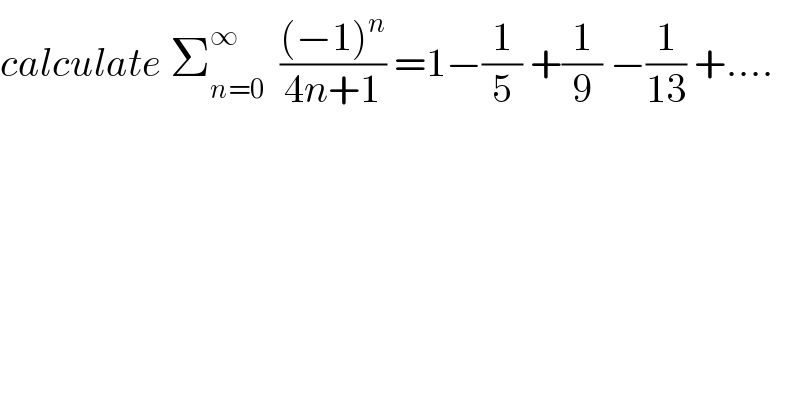
Question and Answers Forum
Previous in Relation and Functions Next in Relation and Functions
Question Number 53795 by maxmathsup by imad last updated on 25/Jan/19

Commented by maxmathsup by imad last updated on 26/Jan/19
![let S(x)=Σ_(n=0) ^∞ (((−1)^n )/(4n+1)) x^(4n+1) with∣x∣<1 due to uniform convergence we have (d/dx)S(x) =Σ_(n=0) ^∞ (−1)^n x^(4n) =Σ_(n=0) ^∞ (−x^4 )^n =(1/(1+x^4 )) ⇒S(x)=∫_0 ^x (dt/(t^4 +1)) +c c=S(0)=0 ⇒S(x)=∫_0 ^x (dt/(t^4 +1)) and Σ_(n=0) ^∞ (((−1)^n )/(4n+1)) =S(1)=∫_0 ^1 (dt/(t^4 +1)) let decompose F(t) =(1/(t^4 +1)) ⇒ F(t)=(1/((t^2 +1)^2 −2t^2 )) =(1/((t^2 +(√2)t +1)(t^2 −(√2)t +1))) =((at+b)/(t^2 +(√2)t +1)) +((ct +d)/(t^2 −(√2)t +1)) F(−t) =F(t) ⇒((−at +b)/(t^2 −(√2)t +1)) +((−bt +c)/(t^2 +(√2)t +1)) =F(t) ⇒c=−a and d=b ⇒ F(t) =((at +b)/(t^2 +(√2)t +1)) +((−at +b)/(t^2 −(√2)t +1)) F(0) =1 =2b ⇒b =(1/2) F(1) =(1/2) =((a +b)/(2+(√2))) +((−a+b)/(2−(√2))) ⇒ (1/2) =(((2−(√2))(a+(1/2))+(2+(√2))(−a+(1/2)))/2) ⇒ −2(√2)a +(1/(2 ))(4) =1 ⇒ −2(√2)a =−1 ⇒a =(1/(2(√2))) ⇒ F(t) = (((t/(2(√2)))+(1/2))/(t^2 +(√2)t +1)) +((−(t/(2(√2)))+(1/2))/(t^2 −(√2)t +1)) =(1/(2(√2))){ ((t+(√2))/(t^2 +(√2)t +1)) +((−t +(√2))/(t^2 −(√2)t +1))} ⇒ ∫_0 ^1 (dt/(t^4 +1)) =((√2)/4){ ∫_0 ^1 ((t+(√2))/(t^2 +(√2)t +1))dt − ∫_0 ^1 ((t−(√2))/(t^2 −(√2)t +1))} =((√2)/4){ (1/2) ∫_0 ^1 ((2t +(√2) +(√2))/(t^2 +(√2)t +1)) dt −(1/2)∫_0 ^1 ((2t−(√2)−(√2))/(t^2 −(√2)t +1)) dt} =((√2)/8){ [ln(t^2 +(√2)t +1)]_0 ^1 −[ln(t^2 −(√2)t +1)]_0 ^1 +(√2)∫_0 ^1 (dt/(t^2 +(√2)t +1)) +(√2)∫_0 ^1 (dt/(t^2 −(√2)t +1))} =((√2)/8){ ln(2+(√2))−ln(2−(√2))} +(1/4){ ∫_0 ^1 (dt/(t^2 +(√2)t +1)) +∫_0 ^1 (dt/(t^2 −(√2)t +1))} but ∫_0 ^1 (dt/(t^2 +(√2)t +1)) = ∫_0 ^1 (dt/(t^2 +2 ((√2)/2)t +(1/2)+(1/2))) =∫_0 ^1 (dt/((t+(1/(√2)))^2 +(1/2))) =_(t +(1/(√2))=(u/(√2))) ∫_1 ^(1+(√2)) (du/((√2)(1/2)(1+u^2 ))) =(√2) ∫_1 ^(1+(√2)) (du/u) =(√2){arctan((√2)+1)−(π/4)} ∫_0 ^1 (dt/(t^2 −(√2)t +1)) = ∫_0 ^1 (dt/((t−(1/(√2)))^2 +(1/2))) =_(t−(1/(√2))=(u/(√2))) ∫_(−1) ^((√2)−1) (du/((√2)(1/2)(1+u^2 ))) =(√2){arctan((√2)−1) +(π/4)} ⇒ ∫_0 ^1 (dt/(t^4 +1)) =((√2)/8)ln(((2+(√2))/(2−(√2)))) +((√2)/4){ arctan((√2)+1) +arctan((√2)−1)} but arctan((√2)−1) =arctan( (1/((√2)+1)))=(π/2) −arctan((√2)+1) ⇒ ∫_0 ^1 (dt/(t^4 +1)) =((√2)/8)ln(((2+(√2))/(2−(√2)))) +((π(√2))/8) ⇒ Σ_(n=0) ^∞ (((−1)^n )/(4n+1)) =((√2)/8)ln(((2+(√2))/(2−(√2))))+((π(√2))/8) .](Q53887.png)
Answered by Smail last updated on 26/Jan/19
![(1/(1−x))=Σ_(n=0) ^∞ x^n So (1/(1+x^4 ))=Σ_(n=0) ^∞ (−1)^n x^(4n) let p(x)=∫_0 ^x (dt/(1+t^4 ))=Σ_(n=0) ^∞ (−1)^n ∫_0 ^x t^(4n) dt=Σ_(n=0) ^∞ (((−1)^n )/(4n+1))x^(4n+1) p(1)=Σ_(n=0) ^∞ (((−1)^n )/(4n+1)) p(x)=∫_0 ^x (dt/(1+t^4 ))=∫_0 ^x (dt/((t^2 +(√2)t+1)(t^2 −(√2)t+1))) (1/(1+t^4 ))=((at+b)/(t^2 +(√2)t+1))+((ct+d)/(t^2 −(√2)t+1)) a=−c=((√2)/4) ; d=b=(1/2) p(x)=((√2)/4)∫_0 ^x (((t+(√2))/(t^2 +(√2)t+1))−((t−(√2))/(t^2 −(√2)t+1)))dt p(1)=((√2)/2)∫_0 ^1 (((t+(√2))/(((√2)t+1)^2 +1))−((t−(√2))/(((√2)t−1)^2 +1)))dt u=(√2)t+1 ⇒du=(√2)dt y=(√2)t−1⇒dy=(√2)dt p(1)=((√2)/4)(∫_1 ^((√2)+1) ((u+1)/(u^2 +1))dy−∫_(−1) ^((√2)−1) ((y−1)/(y^2 +1))dy) =((√2)/4)([(1/2)ln(u^2 +1)+tan^(−1) (u)]_1 ^((√2)+1) −[(1/2)ln(y^2 +1)−tan^(−1) (y)]_(−1) ^((√2)−1) ) =((√2)/4)((1/4)ln2+(1/2)ln((√2)+1)+tan^(−1) ((√2)+1)−(π/4)−((1/4)ln(2)+(1/2)ln((√2)−1)−tan^(−1) ((√2)−1)−(π/4))) =((√2)/4)(ln((√2)+1)+tan^(−1) ((√2)+1)+tan^(−1) ((√2)−1)) =((√2)/4)(ln((√2)+1)+((3π)/8)+(π/8)) Σ_(n=0) ^∞ (((−1)^n )/(4n+1))=p(1)=((√2)/4)(ln((√2)+1)+(π/2))](Q53810.png)
Commented by maxmathsup by imad last updated on 26/Jan/19

